Como alterar o local de backup do iTunes
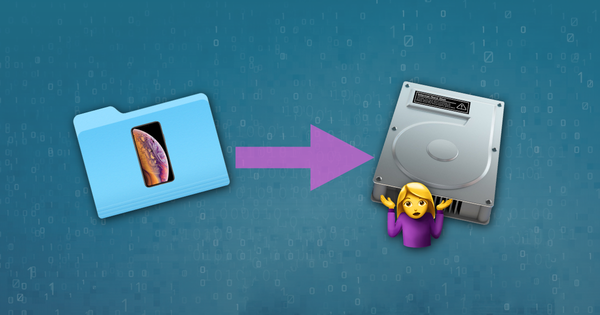
O local de backup padrão do iTunes é definido como o disco principal do PC ou do Mac e, no macOS 10.15, os backups do iOS criados pelo Finder são armazenados no mesmo local. Muitos usuários têm grandes backups ou backups de vários dispositivos iOS e, como conseqüência, ficam com pouco espaço em disco.
É possível configurar um computador para que o iTunes faça backup em um disco rígido secundário ou em um HDD ou NAS externo.
Simplificando, isso é feito substituindo a pasta de backup do iTunes por um link simbólico para o local desejado. Essa é uma alteração facilmente reversível, portanto, é possível restaurar o local de backup padrão em seu diretório original.
Observe que, se o local de backup do iTunes for alterado para um volume que não está disponível o tempo todo, o processo de backup do iTunes falhará quando o novo local estiver indisponível.
O que você precisará
Para alterar o local de backup padrão do iTunes do seu computador, é necessário o seguinte:
- Média competência com um PC ou Mac
- 10 minutos
- Uma compreensão do novo caminho de localização de backup desejado
- Um Mac executando o macOS 10.7 ou mais recente ou um PC executando o Windows Vista ou mais recente
- A equipe de suporte da Reincubate está à disposição para ajudar e pode aconselhar os clientes sobre como fazer isso.
Alterar a pasta de backup do iTunes para iOS automaticamente
A versão gratuita do iPhone Backup Extractor mostrará automaticamente o local de backup do iTunes padrão do seu computador - e permitirá que você o altere.
- Baixe e instale o iPhone Backup Extractor .
- Escolha
Preferencesno menu principal - Selecione
BackupsdePreferencesjanela![O painel "Preferências" mostrando os locais de backup The "Preferences" pane showing backup locations]()
O painel "Preferências" mostrando os locais de backup - Clique no botão
Changepara iniciar o processo de alteração da pasta de backup padrão do iTunes.
Alterando manualmente a pasta de backup do iTunes para iOS no Windows
- Open the default Backup location in Explorer using the Windows Run command. Press
⊞ Win+Rand the Run window should appear. For Windows 7, 8 and Windows 10 iTunes Apple version, enter%APPDATA%\Apple Computer\MobileSyncand press⏎ Enter. For iTunes Microsoft Store version, enter\Users\[USERNAME]\Apple\MobileSync\Backup, where[USERNAME]is your Windows user name. - A janela do Explorer que se abre mostrará uma pasta chamada "Backup". Contém todos os backups do iTunes que já estão presentes no computador. Para alterar o local da pasta de backup, essa pasta deve ser renomeada, movida ou excluída. Por exemplo, pode-se renomeá-lo para "Backup (antigo)".
- Depois que a pasta "Backup" for renomeada, movida ou excluída, um link simbólico poderá ser criado para o local de backup desejado. Para fazer isso, uma janela de comando deve ser aberta.
⇧ Shifte clicando com o botão direito do mouse na janela doMobileSyncExplorer, aberta recentemente, os usuários verão um menu com a opção "Abrir janela de comando aqui" ou "Abrir janela do PowerShell aqui". Clique isso. - Use o seguinte comando
mklink /d Backup "[desired-new-backup-path]". Uma vez que este comando tenha sido digitado, pressione⏎ Entere a mudança estará completa. - Depois de reiniciar o Windows, o iTunes armazenará seus backups no novo local.
Alterando manualmente a pasta de backup do iTunes para iOS no macOS
- Inicie o aplicativo macOS Terminal. Isso pode ser encontrado usando o Finder, em
Applications / Utilities / Terminal. Como alternativa, pode ser iniciado usando o Spotlight pressionando⌘ Cmd+e digite "Terminal" antes de pressionar⏎ Enter. - Instrua o Terminal a mudar para o local padrão de backup do iTunes, digitando
cd ~/Library/Application\ Support/MobileSynce pressionando⏎ Enter. - Revelar a pasta de backup atual no Finder, inserindo
open .e, em seguida, pressionando⏎ Enter. - A janela do Finder que se abre mostrará uma pasta chamada "Backup". Contém todos os backups do iTunes que já estão presentes no computador. Para alterar o local da pasta de backup, essa pasta deve ser renomeada, movida ou excluída. Por exemplo, pode-se renomeá-lo para "Backup (antigo)".
- Depois que a pasta "Backup" for renomeada, movida ou excluída, um link simbólico poderá ser criado para o local de backup desejado. Use o seguinte comando
ln -s [desired-new-backup-path] ~/Library/Application\ Support/MobileSync/Backup. Uma vez que este comando tenha sido digitado, pressione⏎ Entere a mudança estará completa. - Depois de reiniciar o Mac, o iTunes armazenará seus backups no novo local.
Como restaurar a pasta de backup do iTunes para seu local original
Se você realizou as etapas acima e deseja reverter a alteração, o processo é direto:
- Navegue até a pasta de backup do iTunes .
- Exclua o link de
Backupque aparecerá lá. - Arraste sua pasta de
Backuporiginal de volta, renomeá-lo, se necessário, para corresponder ao seu nome original.
Outros desafios?
Alguns usuários acessaram pessoas que já moveram a pasta de backup do iTunes para outro local - simplesmente arrastando-a - e agora não têm o symlink necessário para que o iTunes consiga ver o backup.
É fácil resolver isso e existem duas opções:
Arraste a pasta de volta para onde você encontrou originalmente. Se você esqueceu, ele deve ser chamado de
Backupe ele fica em~/Library/Application Support/MobileSync.Crie um link simbólico apontando para ele - da mesma forma que as instruções acima descrevem. Se você está nesta fase, você deve abrir um Terminal e fazer isso:
cd [location of the folder which now has "Backup" in it] ln -s Backup ~/Library/Application\ Support/MobileSync
Deve ser tão simples quanto isso.
Existem situações em que isso não é possível?
Essa técnica funciona em todos os Macs, mas não funcionará em PCs com Windows criados antes de 2000. Antes do lançamento do Windows 2000, o Windows usava sistemas de arquivos formatados em FAT por padrão , e esses não são capazes de criar links simbólicos. Qualquer construção de PC com Windows, desde então, quase certamente estará usando discos de formato NTFS, e eles suportam links simbólicos muito bem. Se você estiver executando o FAT e tentar criar um link, poderá ver este erro: Local volumes are required to complete the operation.
Felizmente, a Microsoft fornece algumas instruções sobre como atualizar um disco de FAT para NTFS . É um pouco mais técnico, mas é possível.
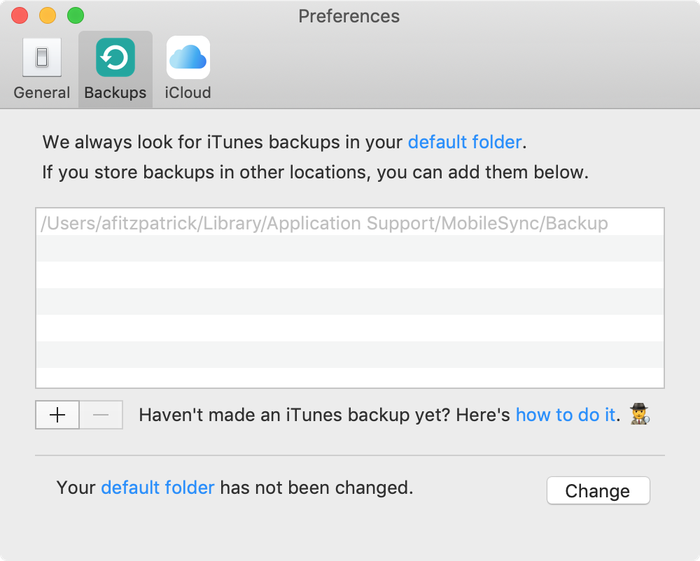
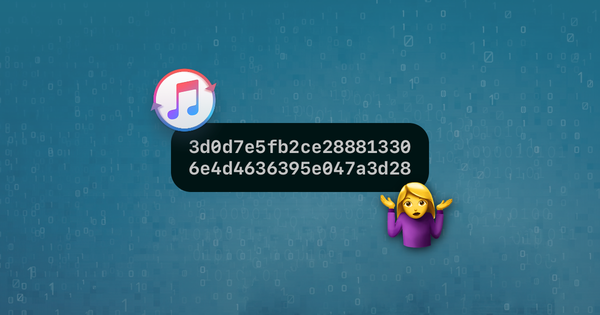

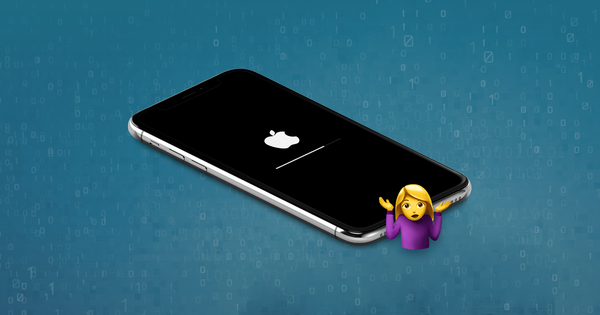
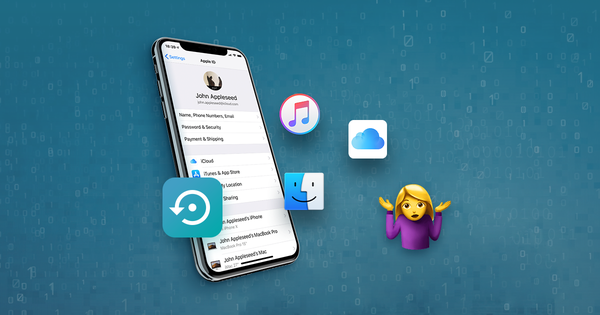

de Gael
Bonjour,
J'essaie tant bien que mal de déplacer ce Backup et de créer un lien symbolique. Cependant, la seule réponse que j'ai est: illegal option -- /
Je vous laisse le chemin que j'utilise et si une âme charitable veut bien m'aiguiller. Merci :)
ln -s/Volumes/VERBATIM\ HD/SAUVEGARDE\ IPHONE/ ~/Library/Application\ Support/MobileSync/Backup ln: illegal option -- / usage: ln [-Ffhinsv] source_file [target_file] ln [-Ffhinsv] source_file ... target_dir link source_file target_file
responder por: Reincubate Support
Salut Gael, merci d'avoir écrit! Le problème ici est l'espace ("") entre votre chemin et les barres obliques.
Il doit s'agir de
ln -s /Volumes/VERBATIM\ HD/SAUVEGARDE\ IPHONE/ ~ /Library/Application\ Support/MobileSync/Backup, et non deln -s / Volumes / VERBATIM \ HD / SAUVEGARDE \ IPHONE / ~ / Library / Application \ Support / MobileSync / BackupFaites-nous savoir si vous avez besoin d'aide! 🙂
de Alex
Backing up to remote Synology server (not local). All you need:
thanks
de Samuel Kwok
Exactly what I needed. I don't want to store on my MacBook as it takes 200GB. This allows me to move to a Time Capsule. I don't use Time Machine but I use Time Capsule as a network drive and another copy of the whole Time Capsule to another network drive.
responder por: Reincubate Support
Glad it helped!
de Rick Galloway
I've got the symbolic link created, but my iPhone back up still goes to the original C: drive location. When I look on my k: drive, I do not see the symbolic link file subdirectory even though it said it was created.
responder por: Reincubate Support
Hi Rick: the symlink should be in your C: drive, in
MobileSync, and calledBackups. It'd be that that points to the K: drive in your case. If you get stuck, why not use the functionality in iPhone Backup Extractor? It can do it for you, and it's in the free edition.de Colleen Gordon
How do I figure out the my desired new backup location path? I want to use an external drive.
responder por: Reincubate Support
Hi Colleen, thanks for commenting. If you use the functionality in iPhone Backup Extractor to change location, you can make the change simply by browsing to the folder you want. That might be easier! 🙂
de Mike L.
A fix to the insufficient permissions error--
Since I got the permissions insufficient in both cmd and powershell. First you search
cmdand then right click the command prompt app and run as admin. Navigate to the directory using the cd command ex.(cd c:\users\youruser\apple\mobilesync). once in the directory you can use the (mklink /d backup [new directory]) command listed in the article. That worked for me.As a side note, when using the cd command to navigate remember that you will likely have to put any folders with a space in the name inside quotation marks ex.(
cd c:\users\"this user"\apple\mobilesync). hopefully this helps some avoid the hassle of having to figure out this process if you get that persistent insufficient permissions response.de Aaron
Hello Aidan!
So I'm trying to change the backup path on Windows, and of course get the "insufficient privilege" error in the regular Powershell. So I ran it as administrator by typing it in the search bar and it said it created the symbolic link to the location, so I restarted my PC & tried updating iOs but the backup still went through to the original location (my hard drive, while I wanna change it to an external one simply 'cause I don't have enough space left on the former, lol).
So I guess my question is: how do I run Powershell in the MobileSync window as admin/how do I get the one I open through the search bar as admin to go to the MobileSync folder location so I can properly create the symbolic link & switch it up? :/
P.S. I did skip step one if I'm being honest, but only did so 'cause I already found the location manually, then proceeded to follow the instructions w/ renaming the folder, etc. Might this be the reason why it's not working? If so, shall I re-rename it to its original "Backup" name and try it again with the 1st step? I doubt it since I can't get the Powershell to go to the MobileSync location while I run it as admin to begin with/can't change it without running it as admin in the aforementioned window...Then again what do I know, lol.
P.P.S. Does the admin-run Powershell not need the MobileSync path to be put in and can successfully render the switcheroo by typing the featured command right after the "system32" path? If so, what seems to be the problem?
I was hoping to update my iOS tonight, and am getting more & more frustrated as we speak. Sorry for the post being so jumbled, hope all's clear. Thanks for the help!
responder por: Reincubate Support
Hi Aaron, thanks for the comment.
Yes, if you skipped step 1 your Powershell will be looking in the wrong folder, so it won't have created the symbolic link in the right place.
If you've already got a Powershell or command window open, you can make it change folder with this command:
cd %APPDATA%\Apple Computer\MobileSync(If it's looking at the wrong drive, you'll have to change drive by typing
C:.)We've reached out to you directly to help, but if anyone else runs into the same problem, we'd recommend undoing the steps you took, starting over, and making sure to include the first step. 🙂
de Mohamed
I tried it, the following error popped up .. Plz advise
responder por: Reincubate Support
Hi Mohamed, it looks like you're using PowerShell to run the command. If that's the case, you must prefix you command with
cmd /c, so it's likecmd /c mklink, etc.de Sean
I'm trying to do this on Mac OS 10.14.6 (Mohave), but when I try Step 5, I receive a "Operation Not Permitted" message. Any ideas...?
responder por: Reincubate Support
Hi Sean, thanks for commenting. On macOS Mojave and newer, you'll need to grant "Full Disk Access" to your Terminal in order to make the change. There's a how-to on how to do this for iPhone Backup Extractor here, I hope that helps!
de Max
Thank you for the article. Here are a few notes to help somebody.
CD(include space). Example:CD C:\Users\Username (change this)\AppData\Roaming\Apple Computer\MobileSyncmklink /d Backup "L:\Users\XYZ"de Joe
I'm still having trouble with permissions, when I open up powershell in admin I get a command line PS
C:\Windows\System32>I don't seem to be able to open it in admin mode from the file path of the itunes back up.responder por: Reincubate Support
Hey Joe, you can change directory using the
cdcommand. Try this:cd %APPDATA%\Apple Computer\MobileSyncde Jess
Thanks for this assistance! I too got stuck on the "you do not have sufficient privilege to perform this operation." I then followed your advice in the comments above and ran Powershell as an administrator, but the Powershell window that opens from the MobileSync folder doesn't seem to recognize that and keeps giving me the same message. What do I do from here? Thanks!
responder por: Reincubate Support
Hey Jess, thanks for writing. It's the same privilege error you're getting? If you drop us a note I'm sure we can guide you through it.
de Андрей
У меня выдает ошибку в PowerShell mklink : Имя "mklink" не распознано как имя командлета, функции, файла сценария или выполняемой программы. Проверьте правильность написания имени, а также наличие и правильность пути, после чего повторите попытку. строка:1 знак:1 + mklink /d Backup "[desired-new-backup-path]" + ~~~~~~ + CategoryInfo : ObjectNotFound: (mklink:String) [], CommandNotFoundException + FullyQualifiedErrorId : CommandNotFoundException
responder por: Reincubate Support
Привет Андрей, попробуй
cmd /c mklinkи так далее 🙂de Hogan
Hi Aidan, Thanks for your amazing instructions!
I have run them on my Mac but got an error saying "Library/Application Support/MobileSync/Backup: No such file or directory". I guess this happened because I have renamed the old "Backup" file. Actually, it also confuses me a lot when u say "Once the 'Backup' folder has been renamed.../Backup", as the original "Backup" file doesn't exist anymore(right?)
Looking forward to your further clarification. Thanks :)
responder por: Reincubate Support
Hi Hogan, thanks for your kind words. That second "Backup" reference is assuming you didn't change the folder's name, but simply moved it elsewhere. If you did rename it, you'd want to change it in that command. I hope this is clear. If it's not, do drop us a note. (Or use iPhone Backup Extractor to move it for you, as the free version can automate this process.)
de Luna
hi i get this message when i try and finalize the path: "You do not have sufficient privilege to perform this operation." It's my computer and i understand it has to do with admin rights but how do i run windows powershell as admin?
responder por: Reincubate Support
Hey Luna! No problem: on Windows, you'd click on the "Start" button, then type "powershell". You'll see the menu search eventually shows you the PowerShell icon. If you right-click on that, you'll see there's a "Run as Administrator" option. Good luck -- I've asked our support team to drop you an email directly in case you need further help. 🙂
de Cedric koh
If I were to delete the backup symlink in the itunes MobileSync folder,how will that affect the backup folder i used for the symlink in my other drive? Will the files inside the backup folder in my other drive be unusable?
responder por: Reincubate Support
Hi, thanks for stopping by. Removing the symlink is safe: it will effectively just remove the pointer to the backup folder on your other drive. The files will still be usable, but iTunes (or Finder) won't know where to look for them.
You could then move the files back to where they were originally -- or create another symlink.
de PBHRider
Great work. How do you come up with this stuff? Did the manual method on Windows 10 using the command prompt with admin privilges and am now backing up my iphones etc to my NAS drive. Saving about 4Gb on my SSD on my laptop. Thank you.
responder por: Reincubate Support
Really pleased it worked out for you. 👍 Don't be a stranger if you need help in future!
de Michael Milbourn
You do not have sufficient privilege to perform this operation. It's my computer, who is not letting me change things on it?
responder por: Reincubate Support
Michael -- if you're on a Windows machine, trying running these commands in a Windows Command that has been launched with "Run as Administrator".
de Lucas
Works like a charm! I followed the instructions for manually changing the iTunes iOS backup folder on Windows (through PowerShell). It is exactly what I was looking for to free up space on my C: drive. Thank you so much Aidan!
responder por: Reincubate Support
Our pleasure, we're glad it helped!
de Brad
Thank you for this
de kalveer kaur lehal
Hi thanks for this. I get an error saying:
Local volumes are required to complete the operation.
How can I fix this please? Thanks
responder por: Reincubate Support
Hi Kalveer, this message suggests your filesystem is FAT-based. I've updated the article to include a mention of why it's not possible to create links on FAT. I've also included a link to instructions on upgrading to NTFS. Good luck!
de Greg
Awesome instructions, thank you! I think there is a typo on step 5 for Mac. The command line is written as
-s [desired-new-backup-path] ~/Library/Application\ Support/MobileSync/Backupbut the folder "Support/MobileSync/Backup" doesn't exist since we moved/deleted it. I had to change it to "Support/MobileSync" and then the folder I linked to was called "Backup".responder por: Reincubate Support
Howdy Greg! Having "Backup" in the path should be correct, as it'll ensure the link that gets created is called "Backup". Makes sense?
We've got something up our sleeves to make this a little easier in future. Keep an eye on the release notes. 😏
de salma
hi ! i did all the steps but i kinda don't get where is the new backup location now ?
responder por: Reincubate Support
Hi Salma -- the new location will be the folder you created the link to!
de Clint
Firstly Aidan - thank you very much for this.
My main drive is a (relatively) small SSD and I would like to be able to save my iTunes backups to the NAS setup instead. You have provided a fantastic workaround!
One thing I wasn't sure about was at step 3 (Windows) - when you right-click (to choose "Open PowerShell window here"), is that in the Explorer window of the now renamed Backup folder? Eg, in the now-named "BackupOld" folder window?
responder por: Reincubate Support
Hi Clint, thanks for your kind words. I've updated the article to make it crystal clear: the window you right-click in is the one you opened at
%APPDATA%\Apple Computer\MobileSync.de Hugues Larouche
And how do you reverse it on Windows PC ? Thx
responder por: Reincubate Support
Hugues, thanks for your comment. I've updated the article to explain that!
de Fred Brunson
Aidan, I don't understand your instructions in How to change the iTunes backup location. What do you mean by prefix your command in PowerShell with cmd /c, like mklink /J Backup "[desired-new-backup-path]".
responder por: Reincubate Support
Hey Fred, thanks for asking. Just like this:
I'll tweak the explanatory text to make it clearer.